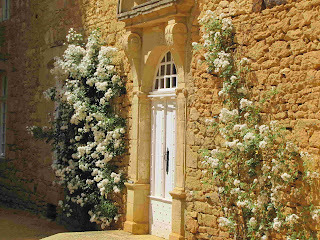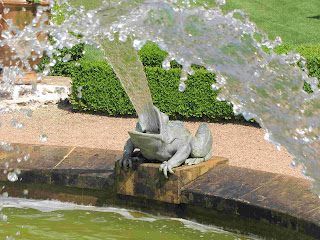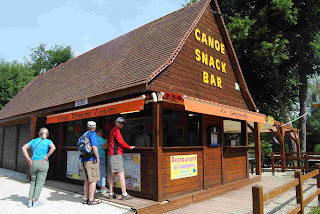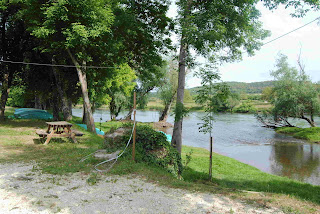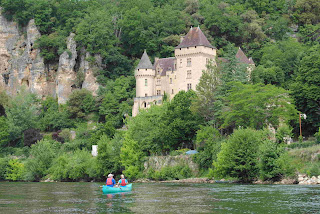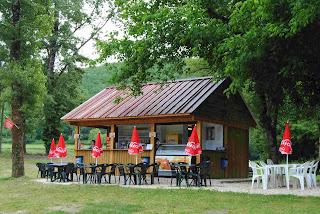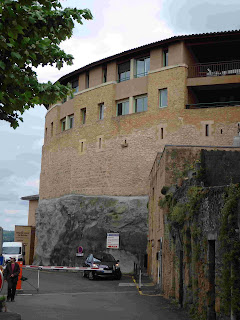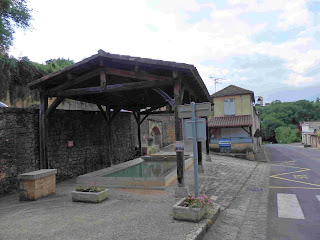We've lunched at the Cahors bridge with Janis and Clark and now want to go back to see the old medieval town. Then for the afternoon, we will visit a "Most Beautiful Village" St. Cirq-LaPopie (pronounced San sear la po py), population 217 in the summer, 30 in the winter.
We arrive in Cahors shortly before 11 and head for the tourist office where we get not only a map of the town, but a wine map of the Cahors region like the one we got for Bergerac. Then we head off for the medieval city center with a warning that there's a market today.
 |
| Flower market on the large square outside the old part of the city and in front of the tourist office. |
And what a market - starting outside the tourist office with a flower market before even entering the market square a couple of blocks later.
The market is buzzing today and totally overrun with people. More crowded than Sarlat which we thought was impossible. But fewer tourists. These folks are serious shoppers as can be judged by their carts and baskets.
 |
Locals have carts, bags and baskets for transporting their purchases
It's a good thing 'cuz the bags get heavy, we've noticed. |
 |
| The market is, as usual, a lively place to visit |
 |
Elbow to elbow crowds at the market. Church watchtower in background
Taken in Market square |
There are the usual food stuffs - fish, meat, cheese, vegetables and local specialties. But also clothes, household goods, shoes, bags and accessories. Markets typically only last a half day, closing around noon. Once closing time is reached, vendors pack up to get ready for whichever town they will be at on the next day.
 |
| Market over, panel trucks (mostly white) pack up the tables, umbrellas, and stock to take to the whatever market is the next day |
We fight our way to the end of the market square to the 12th century Cathedrale de St-Etienne de Cahors. This building looks fortified for good reason - the powerful bishops of Cahors were also counts and barons, powerful feudal lords of the region.
 |
| The center bell tower is flanked by two watchtowers reminding of its one-time military function |
 |
Flamboyant gothic cloister reminiscent of Cadouin, but with much less intact sculpture.
The towers and domes of the church rise above the cloister. |
The cathedral has 2 large frescoed Byzantine-style domes in an otherwise Romanesque fortified church. There is a huge organ over the narthex which happily for us is being played in concert, complete with a planned program and an organist explaining the pieces being played. We've arrived near the end of the free concert, so I sit to listen to the last piece. The music fills the church with sound that would impress any congregant. At the end, the organist comes down and I'm able to get a photo of him.
 |
| seats had been turned toward the back of the church for the organ concert |
 |
| the organ |
 |
| the organist |
We continue our walking tour of the old city which has several narrow streets of medieval and 15th century buildings. Along the way, we come to the river where we see a heron standing in the spillway of the dam.
Besides the historic tour, Cahors has a small garden tour. The city has planted many small gardens to with a variety of themes like the rectory kitchen gardens, a medicinal garden, and a garden with specimens of trees mentioned in the Bible.
 |
| Renovated house with lovely garden |
We lunch at the Cahors bridge, photos of which are in a previous post, then make our way to a Most Beautiful Village, St. Cirq-LaPopie. The place is crawling with tourists, which we should have expected if we had looked at the calendar and realized this was Pentecost Sunday and a National Holiday and long weekend. Oh, well. The French must consider this a good thing to visit on their long weekend, so I guess we're in good company.

The village has 217 full time residents and only 30 in the winter. I'm thinking if I were a resident, I'd want to be there in the winter and leave for the summer. It must be impossible with all the tourists. There's a ruined castle once the stronghold of the LaPopie family, hence the second part of the town's name. The entire town perches on a narrow ridge and is rarely wider than one street, The steepness of the ridge makes for stunning vistas of the surrounding countryside and views of red-tiled roofs of the buildings below the town place. Of course it's a town of restaurants and tourist shops. Nevertheless, it's a beautiful place to see. Oh, and a fortified church, which with its castle reminds of its early life as a strategic defense along the Lot River which flows below it.
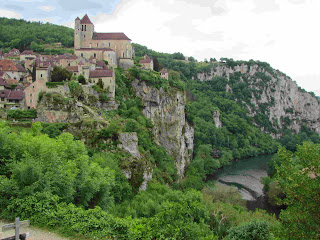 |
| View of the town and the River Lot below it. |
 |
| View of the river and surrounding countryside from just below the church |
 |
| View of the main square of the town. This is the most open area in the whole town. |
 |
| Looking through a "ruelle" passageway to a back street |
 |
| Looking down from the main square of town to the street below. Steep streets make for difficult walking and sore knees. |
 |
| Dennis at the edge of town. Notice the roof tiles behind him. The hill drops off 15 feet to the next level. |




